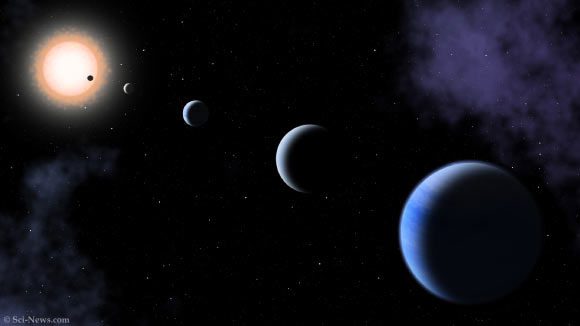Around an orange dwarf star located just 130 light-years from Earth, scientists have discovered a type of planet that has never been seen before and is difficult to explain.
Astronomer Susana Barros from the Institute of Astrophysics and Space Science (IA – Portugal) reported that two new “treasures” are among the five planets orbiting the orange dwarf star HD 23472.
According to Science Alert, over nearly two years – from July 2019 to April 2021 – Dr. Barros’s research team collected data from radial velocity measurements of the star using the ESPRESSO spectrograph on the Very Large Telescope of the European Southern Observatory (ESO).

Graphic depicting a system of 5 planets – (Image: SCI-NEWS)
They identified all five exoplanets around this “orange sun.” The closest is HD 23472d, with an orbital period of 3.98 days, a radius of 0.75 times that of Earth, and a mass of about 0.54 times that of Earth. Next is HD 23472e, with a period of 7.9 days, a radius of 0.82 times Earth, and a mass of 0.76 times Earth.
The third planet, HD 23472f, is slightly larger than Earth, about 1.13 times its size, but has a mass only 0.64 times that of Earth, with a period of 12.16 days. Following that is HD 23472b, which is twice the size of Earth and has a mass 8.42 times greater – possibly a super-Earth, with a period of 17.67 days.
The farthest is HD 23472c, which is 3.37 times larger than Earth, with a mass 1.85 times greater, and a year there lasts 29.8 of our days.
The two treasures are the two closest and smallest planets, HD 23472d and HD 23472e. They are a rare type of planet known as “super-Mercuries” – similar to Mercury but larger, astonishingly appearing as a pair.
Mercury in our Solar System is known as a planet that has been “robbed of its soul,” lacking an atmosphere, which results in no distinct seasons, with extreme temperatures ranging from -173 degrees Celsius at night to 427 degrees during the day.
Mercury orbits the Sun with a high eccentricity, meaning it has a long elliptical orbit, and its surface is riddled with impact craters like the Moon, having ceased geological activity billions of years ago. Overall, it qualifies as a “hellish” world with all the factors that destroy life combined.
The main hypothesis for the existence of such a deadly planet is a violent collision during the planet’s “infant” stage, which caused it to become oddly eccentric and lose its atmosphere.
The second, less solid hypothesis suggests that something mysterious stripped away various types of material from the planet in a literal sense, completely stealing its “soul” and turning it into a dead rock.
However, with the discovery of these two “super-Mercuries,” the previously most reasonable hypothesis of catastrophic collisions seems to have collapsed, as it is difficult to imagine two major collisions occurring simultaneously, in the same manner, to create two dead rocks side by side.
The authors also caution that the lack of an atmosphere on these two super-Mercuries is only indirectly indicated through density measurements and will need to be confirmed by a more powerful telescope.
This is certainly something they will continue to pursue. Dr. Barros stated that this initial discovery opens a new window for astronomers to learn about how such bizarre and rare planets form. At 130 light-years from their parent star, they remain among the closest worlds outside our Solar System ever discovered.
The research has just been published in the scientific journal Astronomy & Astrophysics.





















































